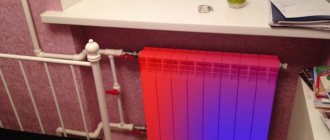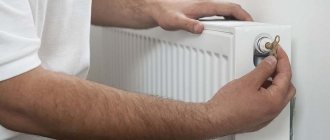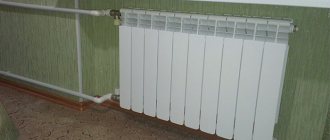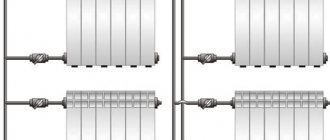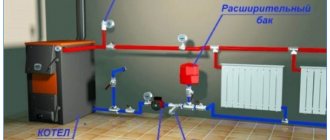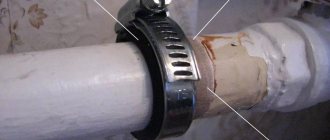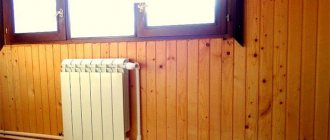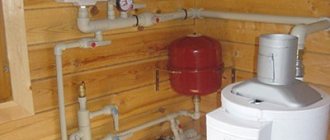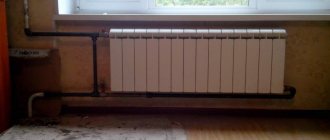Very often on thematic forums the question of why the last battery is cold is discussed. This applies to both the heating circuit of a private house and the distribution of centralized heat supply in multi-apartment buildings. A situation may also arise when the heating element does not heat while being in the middle of the wiring. It is impossible to answer such questions unambiguously. After all, there can be many reasons for such a situation. Also read: “Why is half of the radiator cold?”
Why do the batteries in the apartment not warm up well?
Reason 1: air locks
Often the radiators in the apartment are cold or not warm enough due to air locks. As a rule, this problem is relevant for residents of upper floors, since the air tends upward through the pipes. In order to eliminate air jams, a Mayevsky crane is used. It allows you to release the collected air and ensure full circulation of the coolant in the pipes.
Reason 2: non-optimal connection of heating batteries
The first sign of an incorrect connection is uneven heating of the battery. The radiator will not heat up enough if the water supply comes from below. In this case, it is best to change the connection diagram from the side or bottom to diagonal.
Reason 3: a large number of radiator sections
Uneven and weak heating of the radiator may be the result of too many sections. It is better not to allow the battery to be installed in more than 12 sections.
Reason 4: low coolant temperature
Sometimes batteries remain cold in winter due to the low temperature of the coolant itself (water). In this case, you must contact the house management.
Why do batteries in a private house not warm up well?
Just as in the case of a high-rise building, there may be several reasons for the poor performance of heating batteries in a private house.
Reason 1: problems in the hydraulics of the heating system
The most common reason why radiators remain cold is due to the hydraulics of the heating system. In this case, one of the heating branches is working properly, and the second is intermittent. This picture is typical for a new heating system or when adding radiators to an existing one. If the hydraulics are incorrectly calculated, and in particular the diameters and lengths of pipes, some batteries may simply not heat up. You can adjust the hydraulics using special taps.
Reason 2: single-pipe heating system
In many private homes there are single-pipe heating systems. In such a system, batteries remote from the boiler often heat much worse than those nearby. This does not mean that there are problems; this is the nature of the operation of a single-pipe system. The only solution here can only be to replace the system with a two-pipe one.
Reason 3: boiler malfunction
The batteries may not warm up due to malfunctions in boilers with built-in automation, pumps and sensors, which is a typical problem for autonomous heating systems. In this case, you must contact a specialist who works with such equipment directly.
Convector batteries at home, which ones should I replace them with?
If it’s cold at home, which convector batteries should I change to? Sooner or later, many property owners who have heating convectors installed are faced with the fact that they stop heating. Then they have to be changed. What to replace with:
- Cast iron radiators. This is the oldest type of battery. They are inexpensive and durable, with a service life of more than 50 years.
- Aluminum. As the name suggests, these are radiators made entirely of aluminum. There are two types of them - injection and extrusion. They are best used for autonomous heating. They are not suitable for a centralized heating system due to pressure and corrosion caused by poor-quality coolant.
- Bimetallic. Such radiators consist of a tubular steel core and an aluminum surface. They are reliable and durable, but are quite expensive.
What to do if the bottom of the battery is colder than the top?
If the battery is hot on top and cold on the bottom, it is not functioning properly. In this case, diagnostics are required not only by the battery itself, but also by the entire heating system. The cause of the problem may lie in recent work on the heating system and replacement of the radiator. As a rule, the “hot top – cold bottom” problem appears due to an air lock (99% of cases) or a clogged radiator valve (a consequence of improper start-up of the system).
This problem is solved in two ways. You can remove the air lock using a Mayevsky tap or a bleeder. First of all, turn off the coolant supply to the radiator and leave the return line open. Open the drain, wait until the air comes out, close the drain and open the coolant supply. As a rule, this is enough.
If this method does not work, and we are talking about an apartment building, it is better to call a specialist. For private houses there is another option. First you need to turn off the heating supply, open the drain at the highest point of the system and use back pressure to squeeze out all the air.
Each heating system may have its own characteristics, and therefore there is a high probability of atypical problems arising. These include incorrectly selected pipe diameters, incorrect coolant distribution, poor throughput, lack of pressure, problems with the circulation pump or expansion tank. In any case, only a specialist can fully understand all the nuances, so in case of difficulties in solving the problem, it is better to seek help.
Causes of cold radiators
If, with the onset of cold weather and the heating season, heating is provided to your home, but the radiators do not work, then the problem may be a technical malfunction or the functioning of the entire supply system.
Especially if we are talking about a city apartment, the provision of heat in which should be handled by the housing and communal services service or another authorized body that checks the preparedness of the entire system for the heating season. Well, in the case of a private house, solving problems falls on your shoulders. If you wish, you can contact the Eurolux Group company; this company will carry out all the work quickly and inexpensively.
And here it is important to understand the main causes and individual problems that will need to be eliminated in order for the batteries to give off the maximum amount of heat
The main factors that cause batteries to remain cold can be identified:
- presence of air pockets in the heating system;
- technical blockage of a single battery;
- incorrect connection of each of the elements and the entire system as a whole.
These criteria can affect the performance of both the individual battery and the overall system. Only after these problems have been eliminated will it be possible to talk about the full functional operation of the heating system in each room.
Let's consider each reason separately.
Air jams
When studying the functional features and eliminating the problems of cold radiators and batteries, it is important to take care not only of one of them, but also to check the condition of the entire system. This type of solution requires testing for operability if there are air pockets in the system
Traffic jams can occur due to the appearance of excess air during radiator operation. At the same time, if we are talking about a city house, then, as a rule, the upper floors of high-rise buildings suffer.
But this problem can be easily fixed. To do this, in modern batteries special valves are installed in the upper part, which allow the accumulated air to be removed, restoring the operation of the system.
Heating system clogged
If heating has already been turned on in the system, and you still have cold radiators, there is a possibility that the existing system elements are clogged. This can be either the deposition of the corrosive properties of the metal or the gradual accumulation of scale and large amounts of dirt on the walls of radiators.
To perform flushing efficiently and quickly, follow these recommendations:
- move furniture aside, remove curtains, cover the floor with cellophane or cloth to avoid damage;
- shut off the coolant supply using the shut-off valve. If it is not installed, remove the battery, unscrew it and pour the liquid into a basin;
- to clean the radiator, it must be moved to a bathtub, at the bottom of which it is recommended to place a wooden floor;
- Using a wrench, unscrew the end caps and allow the dirty liquid to flow out of the battery into the bath;
- pour water under pressure from a hose into the battery;
- If a crystalline blockage has formed, it should be cleaned using a special reagent. Through the use of a chemical formula and high-quality pressure in the system, it is possible to remove existing problem areas of scale and corrosion and obtain warm and fully functioning batteries again. You can also use a 70% solution of vinegar and water;
- pour the reagent or vinegar solution into the battery, close the seals and let it brew for 2 hours;
- Rinse the battery inside and outside under high pressure water, wipe the battery dry and install it on the bracket.
Sometimes such actions do not help and you have to buy a new battery.
Connection errors
Also, a separate point may be such a reason as incorrect connection of each element of the heating system. Sometimes the supply pipes with the coolant and the supplied liquid are fixed from below.
This does not allow the battery to gain maximum heat, and the upper areas may remain cold. In this case, it is necessary to reinstall the connection elements and release heat through the upper section of the supply pipes and connections.
Why is the last battery cold in a private house? Why are the batteries cold?
Airlock. If there is a valve, open it and release the bubbles. New batteries usually have valves installed. You can knock on the pipes and shake them to let the air out. Install a pump, it can push through. And it will heat up faster when you first turn it on.
If it is clogged, tap the pipe, especially at the junction with the main pipe and the supply and return pipes.
on Saturday I did it in 3 rooms and a kitchen.. everything came out fine
400 HP, these are batteries + work
in corner apartments they always put an additional radiator on the end wall; I myself live in the first one, but not in the corner one when I bought the apartment, there were double radiators since the house was built, initially I changed them “to my mind.” that is, I made a project. They came to me and calculated which ones to buy. Well, they are so thick and long. They heat up normally))) so according to the law, everything is possible, as I wrote.
cost of batteries, spare parts (spare parts cost about 15 lats (if copper)) + 25 for work + 10 for shutdown and this is all for one battery, if you want 2 multiply by 2 it took 3 hours
Call your friends. A person exhales almost 37 degrees. What is not a heater
You asked it anyway. No, the fact that I can now still see what’s going on behind the battery won’t make me any warmer!
Cold water is rigas udens. call them, they will send plumbers and tell you what to do
The supply temperature is controlled automatically in your heating unit. As a result, either the heating curve is incorrectly configured, or the outside temperature sensor is not working correctly, or the two-way controller is faulty. contact the building manager
Or someone at home secretly installed batteries of unrated capacity, with a large margin. Why is it that he has Tashkent at home, and everyone else in the house is freezing at 15-18 degrees?
Causes of heating problems
First you need to make sure that the heating is really turned on, and the heating system of the apartment receives coolant at the required temperature. In the absence of problems with the central network, the causes of cold radiators include:
- presence of air pockets in the system;
- clogged batteries;
- Incorrect connection of heating network elements.
In each situation, a certain amount of work will need to be done to make cold radiators hot.
Demand what you paid for
Heating of apartment buildings is a service provided by heat suppliers and every consumer has the right to demand high-quality performance . If you silently wait out the frost with the heaters on, then you pay twice - for heating and for the electricity used for heating. Therefore, do not waste your money - in case of violation, seek recalculation and normal temperature in the apartment.
When cold weather sets in, heating appliances must be turned on in every house or apartment.
And if we are talking about central heating or an existing private boiler with a water heater mechanism and installed radiators, then a logical question arises: how to make the radiators warm.
Sometimes it is not enough to simply turn on the heating and the existing boiler in the house, because there are a large number of problems and nuances that prevent the radiators from becoming warm.
The metal remains cold until the problem of all supplied heat or a particular criterion is eliminated.
Air jams
The most common cause of heating problems is air locks, which are formed due to a leak, rapid filling of the system, or as a result of heating the water. They appear especially often in apartments on the upper floors.
To make cold radiators hot, you need to remove air from the system. Modern models are equipped with special exhaust valves located at the top of the batteries and operating in automatic mode. Also, a Mayevsky valve or drain valve can be installed on the radiators, with the help of which air is removed manually.
The Mayevsky valve is a cone-shaped rod with a thread, when unscrewed, a through hole opens and the gaseous medium is removed from the coolant.
What to do if they are absent? If heating is turned on, but the radiators remain cold, you should contact the management company or the housing office and call a plumber to remove air from the system. Typically, a preventive check is carried out after supplying coolant to the system to prevent uneven heating.
How to eliminate uneven heat transfer
Not all problems can be solved on your own. Poor heat transfer from the radiator may be a consequence of non-compliance with the slopes, indicating gross violations in the installation of the heating system. In this case, you will have to invite a specialist in heating systems.
Some heating problems can be fixed on your own.
Air locks - air in the heating system is an inevitable consequence of filling pipes and radiators with coolant. A characteristic sign of the problem is that the radiator is warm at the bottom and cold at the top. If the section heats up unevenly, you can try to bleed air from the system using the Mayevsky valve. Some owners initially install an automatic air release valve.
Connection errors
Another reason why they may remain cold is incorrect connection of the heating system elements. The worst mistake is considered to be connecting radiators to pipes, in which water is supplied from below. In this case, the sections are heated unevenly, and part of it remains cold. This is most often typical for side connections. What should I do to ensure that the surface of the radiators heats up evenly and the apartment becomes warm? To do this, you need to correctly connect them to the system.
Too many sections can also contribute to uneven heating, since coolant circulation is difficult. A special extension cord connected to the pipe that supplies hot water to the battery will help improve it.
Advice! For uniform heating of radiators, the best option is a diagonal connection, which ensures maximum efficiency of the heating system.
System operation and maintenance
The mechanism that brings heat to apartments is multi-stage. Consequently, a separate organization is responsible for each section of the heating system. Inside the house, in accordance with the standards, the service organization inspects, repairs and evaluates the condition of utility networks:
- Management Company;
- housing cooperative;
- homeowners association.
As a rule, they hire a specialist to do this. He identifies and, if necessary, corrects equipment malfunctions, evaluates the quality of services and possible causes of excessive heat consumption. The inspection is usually carried out once a year and coincides with the start of commissioning of the system.
Heating system clogged
Batteries are often cold due to deposits on the inner walls of the case. The reason for their appearance is various impurities in the composition of the coolant and products of the interaction of hot water and metal. What to do in this case?
Cleaning radiators in an apartment is carried out in several ways, each of which requires certain equipment and conditions of execution.
If at the inlet and outlet of the coolant, then it is possible even with the heating running. To do this, the radiator is removed and the dirt is washed off with a strong stream of water. If unsuccessful, the sediment from the walls of the housing is removed using chemicals. After drying, the heating device is installed in its place, and the joints are carefully sealed.
It is possible to remove deposits from the walls of batteries without removing them. This is done using special equipment using the following methods:
- Chemical. It is carried out using solutions of organic and mineral acids, alkali and other compounds. It is produced using special equipment, consisting of a pump, a container for cleaning fluid and hoses. The method is indispensable for steel pipes.
- Hydropneumatic. Used when there is equipment that can create high pressure. Water is used as a cleaning liquid, due to which turbulent flows are formed that destroy deposits on the walls of pipes and radiators.
- Hydrodynamic. It is carried out with a jet of water under high pressure; the supply of liquid to hard-to-reach places is ensured through various nozzles. The cleaning method is effective for heating elements made of cast iron and is expensive.
- Pneumohydropulse. Suitable for batteries and pipes with a diameter of no more than 150 mm. Deposits are removed using a water pneumatic gun, which can act in a targeted manner.
As a result of a thorough study of the causes of uneven heating and proper elimination of it, cold radiators will become hot, and the living quarters will have a comfortable temperature.
After putting the central heating system into operation, it takes some time for it to come into operation.
Troubleshooting a two-pipe heating system (continued)
The second article in the series of troubleshooting in the heating system
Dmitry Belkin
Author: Dmitry Belkin
Quite a significant amount of time has passed since the first article was written and, on the eve of the 2011-2012 heating season, I decided to continue the cycle, especially since questions on the topic “I installed the heating, but it doesn’t work”
keep coming.
Unfortunately, troubleshooting methods that do not lie on the surface are quite difficult to classify, and I decided to devote several short articles to the issue of heating system malfunctions. In this article I would like to consider the problem of poor coolant circulation and uneven heating of radiators. I myself have never made mistakes similar to those described and, accordingly, here I will have to theorize a little.
Friends! Before troubleshooting your heating, please find the dirt filter and clean it! Perhaps after this there will be nothing left to look for!
So, we have two-pipe heating. Let's consider one branch of this heating system, serving, say, one floor. Here is her diagram. The water flow is shown by arrows.
The radiator located closer to the beginning of the branch, or to the boiler, is hot. This is the leftmost radiator. There may be significantly more radiators than shown in the diagram. For example, in my tiny house there are 3 branches. The longest one is about 25 meters long and has 5 radiators. The problem is that the radiators next to the first are either completely cold or have a temperature significantly lower than that of the first. Moreover, the further to the end of the branch, the colder and colder the radiators are.
Our first radiator is hot (my hand can barely stand it). We feel the next ones and find that all the radiators are hot, but their temperature decreases as we move along the branch. The latter is no longer hot, but slightly warm. We return to the first radiator, but feel its bottom. We feel the bottom of all the radiators along the branch and find that the bottom of the radiators is much colder than their top. Even the first one.
Conclusion
We have water circulation in our heating branch. There is no air in the pipes. However, the circulation is not fast enough. It is so weak that the water has time to cool while it moves from the radiator inlet to its outlet. Thus, the problem is diagnosed. All we have to do is find its cause and destroy it.
Do we have a circulation pump in our system?
If it is not there, then the problem of accelerating circulation is quite difficult to solve. You need to place the boiler lower, you need to increase the diameter of the riser, you need to increase the diameter of the supply and return lines (horizontal lines), you need to change the pipes to ones with a smoother inner surface, you need to reduce the number of angles and make them obtuse, that is, 100 or 110 degrees. at least more than 90.
If there is a circulation pump, then... solving the problem is not at all easier.
First, let's check if the pump is working. In general, doing this is not as easy as it seems. A good circulation pump operates absolutely silently and without vibration. You can only hear it work by putting your ear to it, but it is hot and you can get burned! I do not recommend that you, dear friends, risk your organs! Stock up on a medical stethoscope or just a large-diameter tube (a piece of plastic sewer pipe with a diameter of 50 mm will do). Attach one end to the motor and stick your ear into the other end. If you hear the motor running, that’s good!
By the way, if your engine is noisy, then it may be broken and needs to be replaced so that it does not become painfully cold, but there is a much higher probability that the air is seething in it. Could this be why the circulation is weak? In this case, turn off the engine and bleed the air. Any engine has means for this. You can drain the water from the pump while it is running, but this must be done extremely carefully so as not to break it (the motor). As soon as water with bubbles stops coming out of the motor, the air release procedure must be stopped, that is, all the holes must be tightened and fresh water added to the system, bringing the pressure on the barometer to the desired level.
Important note!
Re-reading my particularly successful articles, and this article is undoubtedly quite successful, I noticed one inaccuracy. It concerns the release of air on a running pump. The fact is that if your pump is particularly powerful and creates noticeable pressure, then the procedure for bleeding air can turn into airing the entire system. The point is that the water pressure is so high that air is sucked into the system, but the water does not pour out. This depends on the design and power of the pump. Possibly from some other factors. In short, if bleeding is a problem in your system, be sure to turn off the circulator before bleeding. Extra caution doesn't hurt!
Is the pump working? Great! Is it possible to increase the circulation speed on it? Amazing! Let's zoom in and see what happens. If all the radiators became uniformly hotter, then we consider that our branch is simply too long and we used too thin pipes. It is possible that the pipes are of poor quality or there are some obstacles to circulation in the form of a large number of corners, dents in the pipes, and so on. Then we promise ourselves to change everything someday and live in peace. Well, maybe we change the circulation pump to a more powerful one. At the same time, we put up with increased electricity costs. What did you think? Is it so easy to live in a big house? You have to pay for everything.
Let's assume that increasing the circulation speed on the motor did nothing.
We think this is a miracle! Something had to change, or the motor was faulty, after all. At least on the first radiator in the branch, the bottom should become almost as hot as the top. Let's assume there was no miracle! On the first radiator, both the top and bottom became hot, but further down the branch the temperature still does not suit us.
I hope you have valves at least at the inlets of all radiators? We close the valve of the first radiator halfway and feel the rest. Have they gotten hotter? If yes, then we draw the following conclusion.
Conclusion
We have obtained such heating in which it is easier for water to pass through the radiator than to go along the entire branch. Why did it happen? Well, for example, because the diameter of the supply line (or return line, which is the same thing) is smaller than the diameter of the pipes to the inlet and outlet of the radiator. But it should be the other way around. The bore diameter of the lines must be larger than the diameter of the radiator outlets. If you use high-quality, for example, copper pipes, then pipes with an internal diameter of no more than 15 mm should be connected to the radiators. This is enough! Verified by yours truly!
After reaching this remarkable conclusion, we believe that we got off lightly and live by regulating the circulation in our branch with valves. This, of course, does not add comfort. We change the valves to automatic thermostatic ones and, I hope, we get quite normal heating that regulates itself. After this we live in peace.
Next option. Both lines are hot and the radiators are cold. In this case, the valves on the radiators are fully open.
By and large, this is also a miracle. In this case, the radiators cannot be completely cold. But if water rushes along the highways at the speed of a racing car, but does not enter the radiators, then this means that the problem is either in the radiators all at once), or in the node connecting the radiator to the highway, and not necessarily the upper, input node, so to speak . If the problem is in the lower, output node, then the effect will be exactly the same. In other words, if we block the radiator outlet, it will be absolutely cold, as if we blocked the input. Why are control valves placed on top? Just so that you don’t have to bend too low to adjust them, and you don’t accidentally hit them with your foot.
If we consider radiator malfunctions, then it is much more likely that the problem will be in only one of them, but not in all of them at once. In this case, you need to deal with one thing. Most likely the problem is in the valve. This is where I think we should start.
And one last thing. If we have an air lock or blockage in the middle of the line, then what do we get? All radiators and the line will be hot before the blockage, and the supply and return lines immediately behind the operating radiator will be cold.
NOTE!
If this happens, this does not mean at all that the problem is somewhere near the working radiator. The problem can be anywhere in the gap between the supply and return lines between the working radiator and the first non-working one. This is very important to understand! Understanding this crucial point can save you a lot of time and effort. And money too.
I’m not too lazy to even draw a diagram
That's all. I hope this article was useful to someone. As always, I will be glad to receive comments and “cases from life.”
Dmitry Belkin
Article created 10/19/2011
What to do if the apartment is cold?
If at the beginning or the height of the heating season one battery in the apartment or the entire circuit does not work, you must seek help from the organization that supplies the home with heat. To do this, just carefully read the payment receipt. She comes monthly. It must indicate:
- address of the heat supply organization;
- hotline or emergency service telephone number;
- if possible, the address of the organization’s website.
Using this data, it is easy to contact specialists and ask them for help if the heat is on but the batteries are cold.
Try bleeding the air, maybe that's the reason.
How soon should the issue of heating at home be resolved?
According to current legislation, the problem associated with insufficient heating at home must be resolved within the following time frame:
- within 16 hours if the room temperature is within +12°C;
- after 4 hours, if the air in the apartment has warmed up to +10°C.
For each hour exceeding the specified limit, payment for heat provided should be reduced by 10-15%, according to the current tariff. This applies to cases where the radiators in the apartment are not completely heated. What to do if radiators remain cold in a separate room or separate wiring? If it heats, but by half, then there will be no reduction in payment for the services provided. But at the same moment, the consumer has the right to call a specialist from the service organization to fix the breakdown.
Before the specialist arrives, it is necessary to establish that only in one of the rooms there is a cold radiator or the problem extends to the entire apartment, or maybe to the entire riser or entrance. The collected information will help the plumber quickly navigate the site and fix the breakdown as soon as possible.
Causes of low temperature
Based on localization, there are three categories of possible problems leading to low temperatures in radiators and in the room:
- Accidents at the boiler room and insufficient heating of the coolant entering the house system.
- Problems with radiators and pipes in the apartment.
- Poor thermal insulation.
Important! Please note that the temperature of heating radiators is not standardized in any way, only the air temperature in the room plays a role ( +18 for the middle zone, +20 for the north ). If it is normal, then there is no reason to worry, even when the radiators are practically cold.
Accidents are rare and efforts are made to resolve them promptly. A prolonged absence of heating at sub-zero temperatures is very dangerous, so the health of the system is closely monitored. Heat losses are more common due to poor insulation of main pipes - as a result, the temperature of the water reaching the consumer is less than the calculated one, hence cold heating radiators in apartments.
Reference. Resource supply organizations (or heat energy suppliers), which include thermal power plants and boiler houses, draw up a table that determines the level of heating of the coolant depending on the outside temperature. Their work is carried out in accordance with it.
The temperature of the water entering the house system decreases by approximately 20-30% after passing through all the pipes and radiators.
So that the apartment is always warm...
Many ordinary people are wondering if. First of all, you need to inform the company that provides the house with heat. It is its specialists who are obliged to repair the heating circuit as soon as possible. In some cases, utility payments are overrun.
Radiators in the house may be cold due to air in the system, accumulation of dirt in it, low coolant flow, or improper installation of the heating circuit. Only a specialist can correctly determine the nature of the breakdown, and therefore correctly eliminate it. It is prohibited to carry out any adjustment work independently. The question is discussed in more detail in the video:
A cold radiator at the height of the heating season is far from uncommon. This kind of trouble happens not only in an apartment, but also in your own home.
All batteries are hot at the top, but colder at the bottom. However, when the temperature difference is very large, this indicates a problem. After all, the radiator emits much less heat than planned.
The main reasons for this phenomenon
The problem of “cold bottom” (let’s call it that) is faced not only by those whose system is equipped with fairly old heat exchangers, but also by people who have installed bimetallic heating radiators. There are many reasons why this problem occurs, so it is difficult to immediately say why the batteries do not warm up evenly enough. Typically, each specific case should be considered individually. So, let's try to figure out the main reasons for this malfunction.
Reason #1. Normal blockage
The very first (because the most common) reason for this phenomenon is contamination of heating radiators. Here are the main reasons for the temperature decrease in the lower part of the device:
- low-quality coolant is used;
- air has entered the system.
It is worth noting that the working fluid can contain not only heat, but also various solid particles. For example, when the heating season begins, and centralized lines are just starting up, the quality of the working fluid is, to put it mildly, disgusting. Things are much better in the case of an individual heating circuit - contamination can penetrate into it only through an open expansion chamber.
This is all clear, but how can the temperature difference be affected by the presence of air in the system? The explanation for this is very unusual - bacteria are to blame. There is a certain variety of such microorganisms that can exist only in the presence of a sufficient amount of oxygen. Such bacteria are known as anaerobic. There is nothing wrong with them, but their waste products settle at the bottom of the heating radiator in the form of sediment.
Note! It is also worth noting that the working fluid brings sludge into the battery from almost the entire heating line, and it settles there.
Finally, another reason that the bottom of the battery is cold and the top is hot can be considered the special design of the heat exchanger. The liquid moves in it, permanently changing the vector of its own motion. And inside the heat exchanger there is a fairly large number of “secluded places” in which dirt can be deposited.
Video - Cleaning the heating radiator
This reason is more or less clear, so let’s move on to the next one.
Reason #2. Problems with shut-off valves
Sometimes the reason why the temperature of the lower part of the radiator is lower than the upper part can be due to the shut-off valves. In previous articles we have already examined the design features of such reinforcement, so today we will only briefly consider a few main points. The main purpose of shut-off valves in the heating circuit is to regulate, as well as completely/partially block the movement of the working fluid.
The fittings can be the following mechanisms.
- Ball valve.
- Thermal head, which is equipped with mechanical or electronic control.
- Cone valve.
But what does the decrease in temperature at the bottom of the radiator have to do with it, you ask? The fact is that as a result of problems with shut-off valves, the circulation of the working fluid inside the heat exchanger is disrupted. After all, the tap may simply become unusable, which is why the coolant will not flow even in its open position. This, for example, could be a failed damper or any other mechanism failure. It is also worth adding that the correct installation of shut-off valves also plays a very important role in this case.
Note! All taps of this type have an arrow indicating in which direction the working fluid must move in order for the heating line to function normally.
And if the tap is installed incorrectly, then one way or another the movement of the coolant will be disrupted: in this case, it will not matter whether the damper mentioned above is closed or open. We also note that for some types of shut-off valves there are requirements regarding the position in which the valve itself should be located relative to the space. For this reason, in case of problems with the uniform heating of heating devices, the shut-off valves should also be inspected.
Thermostat for heating radiator
Previously, we talked about the types, applications and technical characteristics of thermostats for heating radiators; in addition to this article, we advise you to read this information and read about it here
Reason #3. There is not enough pressure in the system
Low pressure in the line can lead to disruptions in the circulation of the working fluid, as a result of which it may happen that the bottom of the battery is cold and the top is hot. What to do in this case? First, you should make sure that everything is normal with the pressure in the network. As you remember, not so long ago - and we are talking about the times of the Soviet Union - batteries made of cast iron were widely used. They differed in that they had fairly wide passages, therefore, in order for the working fluid to pass through the entire heat exchanger, not so much pressure was required. But modern heating radiators have a slightly different structure.
Quite often, even immediately after purchasing such batteries, people encounter a problem when the upper part has a much higher temperature. This is explained by the fact that the output and inlet pipes, as well as the labyrinth of the heat exchanger itself, have a small nominal bore. For this reason, in the line, which was originally designed for cast iron, the pressure is simply unable to overcome the resistance and “push” the working fluid through the entire heat exchanger.
In addition, the pressure in the heating line may drop for other reasons; let’s take a look at them.
- The neighbors secretly equipped the apartment with a “warm floor” system that runs on water and is connected to centralized high-temperature heating.
- Certain problems arose on the highway itself.
- The same neighbors equipped their bypass with a tap.
- Again, the neighbors significantly increased the volume of the heat exchanger, equipping it with several additional sections.
- Finally, the same people living next door are experimenting with regulating their own heating radiators.
As you can see, often a sudden drop in pressure is associated with some actions of neighbors. As for the extended radiators, the volume of the heat exchanger in which exceeds that of the developer, and the “warm floor” system, it should be noted that all this is contrary to the law. All these manipulations lead to the fact that the pressure in the line decreases, so you shouldn’t even be surprised by the fact that the lower part of the batteries in your house will be cold.
Problems with the radiators themselves
Why is the radiator hot on top and cold on the bottom and how to fix it?
The bottom of the battery is clogged with dirt
- At first in my apartment
. When they are warm, ask your neighbors. - When everything is in order with them and with the heating wiring, as well as with the radiators, it means that the problem is in your device.
- Most often, the reason is that it is clogged with dirt
- metal oxides (rust) and other suspended matter, which, when settled, do not allow the coolant to pass through. Therefore, the top of the radiator is hot and the bottom is cold. - Try warming up the battery in the problem area
. The water will boil there, begin to move, and perhaps the suspension will leave.
Note! Of course, a more effective way to clean the battery is to remove it and wash it. However, you cannot do this work yourself, because... you will have to disconnect the entire heating riser from the water. Housing office workers will refuse to do this in the winter cold. Therefore, the batteries should be washed in advance, before the start of the heating season.
Air in heating devices
Often batteries do not heat well, because... an air plug was created in them. It is formed when the coolant heats up and suddenly fills the heating system with it.
When the radiator is equipped with a release valve, it is not difficult to deal with the problem yourself.
- On modern types of batteries, this device is mounted at the top and functions autonomously, periodically bleeding off excess air.
- Manual valves are also often used. They should be unscrewed and kept in this state until water begins to flow.
- Old battery models do not have taps. But there is a stub.
- Place a basin under the radiator to prevent water from spilling onto the floors. Unscrew the plug until a hissing sound appears. Wait until all the air has escaped and water begins to ooze out. Next, screw the plug back on.
Incorrect installation of heating system elements
The following types of heating pipe connections are now common: diagonal analogue, bottom connection, side installation.
- The instructions now consider the diagonal type of connection to be the most effective.
- The connection is not correct when the coolant supply branch is connected to the bottom of the batteries. Then hot water flows in the lower part of the heating device and does not fully warm it up. Installing a water inflow extension can correct the situation here.
- Lateral connection is also ineffective. Then only the initial sections of the radiators warm up sufficiently, at most 4/6. In this situation, qualified plumbers will be able to help you.
Note! It is very common for the radiators on the top floors of apartment buildings to be hot, but downstairs they are lukewarm. Here the problem is obvious - illiterate design and installation of the heating system. You can’t handle this on your own; you will need to consult an independent heating engineer.
It should be noted that the number of sections in any type of heating system should not exceed the standard limit.
- When heating by gravity (gravity) the radiator should not have more than 12 sections.
- In forced circulation systems, heating devices should not be composed of more than 24 sections. Otherwise, the last of them will still not warm up.
Pressure, water speed and return temperature in the heating system
Basically, the requirements for heating systems imply dividing the specifics of heating into two types:
- independent, here the source of heat energy is located directly in the room - used in an individual house or in multi-storey buildings of an elite type;
- dependent, where a network of pipelines is connected to the heating complex - used in most houses in the urban area and urban-type settlements.
Due to the specific nature of the circulation of the coolant, water is predominantly used, where the speed of water in the heating system directly affects the temperature in the radiators. Circulation is divided into natural (based on the principle of gravity) and forced (heating system using a pump). According to distribution, it is customary to distinguish between a heating system with lower and upper pipe distribution.
Temperature
Despite the wide selection of heating systems provided, the options for heat supply and return are quite limited. The maximum temperature in the heating system must also be set according to the rules in order to avoid further malfunctions.
Radiators are connected to the heating system in one of three ways: bottom, side or diagonal.
Also, the lower connection is also called differently: “Leningradka”, saddle. According to this scheme, the return and supply are installed at the bottom of the battery. In most cases, it is used when pipes are laid under the baseboard or under the floor surface. The return temperature in the heating system should not differ from the supply temperature.
Water speed
If there are few sections, heat transfer will be extremely ineffective compared to other schemes - the speed of water in the heating system decreases, which leads to heat loss.
Side heating is the most popular type of connecting radiator batteries to heating. The supply of water as a heat carrier is carried out in the upper part, and the return is connected from below, so that the return temperature in the heating system is considered equal.
To avoid a decrease in the efficiency of this type of connection when increasing the radiator sections, it is recommended to install an injection tube.
Pressure
The diagonal type of connection is also called a side cross circuit, because the water supply is connected at the top of the radiator, and the return is organized at the bottom of the opposite side. It is advisable to use it when connecting a significant number of sections - with a small number, the pressure in the heating system increases sharply, which can lead to undesirable results, that is, heat transfer can be halved.
To finally settle on one of the options for connecting radiator batteries, you must be guided by the methodology for organizing the return flow. It can be of the following types: single-pipe, double-pipe and hybrid.
The option you should choose will directly depend on a combination of factors. It is necessary to take into account the number of floors of the building, where the heating is connected, the requirements for the price equivalent of the heating system, what type of circulation is used in the coolant, the parameters of the radiator batteries, their dimensions and much more.
Most often, their choice is made on a single-pipe heating pipe layout.
As practice shows, such a scheme is used precisely in modern high-rise buildings.
Such a system has a number of characteristics: they are low in cost, fairly easy to install, and the coolant (hot water) is supplied from above when choosing a vertical heating system.
Also, radiators are connected to the heating system in series type, and this, in turn, does not require a separate riser for organizing the return. In other words, water, having passed the first radiator, flows into the next, then into the third, and so on.
However, there is no way to regulate the uniform heating of radiator batteries and its intensity; high coolant pressure is constantly recorded in them. The further the radiator is installed from the boiler, the more heat transfer decreases.
There is also another wiring method - a 2-pipe scheme, that is, a heating system with return. It is most often used in luxury housing or in individual homes.
Here is a pair of closed circuits, one of them is intended for supplying water to parallel-connected batteries, and the second is for draining it.
Hybrid wiring combines the two schemes described above. This could be a collector circuit, where an individual wiring branch is organized at each level.
Illiterate arrangement of an autonomous heating system
When arranging heating in your home, the question often arises as to why the last radiators in a two-pipe system are cold.
Why do batteries heat poorly in a private home?
In this case, the batteries may be cold from below, when the “return” and “supply” have been confused, or the coolant circulation rate inside the devices is not high enough.
- In the first case, everything is simple. The battery was incorrectly connected to the supply and return pipes of the heating system. Here it is enough to disconnect the radiator and connect it correctly, according to the heating diagram.
- When the radiator is hot at the top and cold at the bottom in the second case, it is explained as follows. When the coolant flows through the system at high speed, its elements will be hot everywhere. When the speed is low, the water gradually cools and becomes colder at the bottom of the radiators.
Conclusion
Ineffective operation of a heating radiator can be caused by completely different factors. First of all, you should understand what the cause of the problems is and only then try to eliminate them. The video in this article is also devoted to this topic.
Very often on thematic forums the question of why the last battery is cold is discussed. This applies to both the heating circuit of a private house and the distribution of centralized heat supply in multi-apartment buildings. A situation may also arise when the heating element does not heat while being in the middle of the wiring. It is impossible to answer such questions unambiguously. After all, there can be many reasons for such a situation. Also read: “Why is half of the radiator cold?”
Which boiler to choose for heating a private house?
Of course, none of the residents of private houses want problems with heating their home, so that during the cold season they do not have to wonder what to do with cold radiators in a private house and do not find out the reasons why, when the boiler is running, the radiators are still cold. Where to write if there are cold radiators in the house? Therefore, the choice of equipment must be approached with full responsibility.
1. Today, gas is one of the most inexpensive options for energy sources. If a private house is connected to a gas main, then, of course, residents choose a gas boiler. However, if a gas line is not installed to the house, then its installation will have a serious impact on the family budget.
If gas is installed in the house, then the installation of the boiler must be carried out by a specialist. It is prohibited to install the equipment yourself. The specialist will have to pay for the work, but you will not have situations where the boiler is hot and the radiators are cold, or the house is cold, although the radiators are hot. And if such a situation does arise, then the installer will be responsible for it, because his work is guaranteed.
2. Solid or liquid fuel equipment. The main disadvantage of such an installation is a separate room, equipped according to standards and equipped with a chimney. This equipment is considered the most dangerous, so its installation must be approved by regulatory authorities. And don’t forget that these boilers are practically not amenable to any kind of customization or automation.
Therefore, if you have questions such as: why are the last radiators cold or why is there a cold radiator in the back room, then you will need the help of a specialist; it will be difficult to solve the problem yourself.
3. Electric boilers. They are the easiest to use and do not require constant monitoring. They are also considered the most fireproof, since their work does not involve open fire. And there will be no problems with them when the boiler is boiling and the batteries are cold.
A big plus is that electric boilers are very compact and look quite modern, so they fit perfectly into the interior of the house.
Global heating circuit problems
Kote doesn't like cold batteries.
The reasons why one battery is hot and another is cold can be global in nature:
- the bypass is installed incorrectly;
- no balancing;
- insufficient pressure.
The bypass is not installed correctly. The bypass is a tube in front of the radiator. It connects the supply of heated coolant and the return. The last battery does not heat well if the bypass is installed too far from it. After all, according to the laws of physics, it will be easier for the coolant to pass through the bypass than through the entire heating element.
The bypass taps directly into the wiring, rather than through a two- or three-way valve. The coolant enters the radiator through outlets. As a result, the cross-section of the supply pipes decreases. There is not enough pressure in the system to push hot water through the circuit. As a result, the last heating radiator does not heat.
Often, when the heating circuit is first started, the last battery in the house does not heat. What to do? Experts recommend not taking radical actions and allowing the system to level out. The air that is in the water must come out naturally. After some time, the heating wiring will function normally.
Error in bypass circuit.
Incorrect installation of the radiator. Why doesn't the last battery heat up? The last radiator in the heating circuit may be too large. It contains more than 12 sections. In this case, the pressure in the system is not enough to drive the coolant through the entire volume of the heating element. The situation is aggravated by the lateral connection. Hot water does not reach the outer sections. As a result, the last heating radiator does not heat well.
Incorrect balancing. Balancing the system means uniform distribution of the coolant throughout the entire heating circuit. It is performed using shut-off and control valves and thermostats. If the last battery in the heating system is cold, then perhaps the problem lies in the uneven distribution of hot water throughout the wiring.
Everything about plastic pipes for heating: characteristics, dimensions, installation.
What thickness should steel pipes be for heating? The answer is here.
Why is half the battery cold?
When the radiator is not connected correctly.
The main reason why the battery is half cold may be that it is connected incorrectly. According to the rules for installing heating equipment in a heating circuit, the pipe supplying hot coolant must be connected to the top of the battery. The cold pipe or return, on the contrary, is to its lower part. Also read: “Radiator brackets.”
How can we explain this?
You need to take into account the laws of physics and remember that hot water is much lighter than cold water, and therefore is located in the upper part of the heating device. Gradually releasing its thermal energy to the surrounding air, the coolant cools down. Its density, and hence its weight, increases. He goes down. That is why often half of the battery is cold and half is hot.
In any case, if the radiator is half cold, you need to seek help from a specialist rather than try to solve the problem yourself. This can lead to equipment damage or injury.
Low coolant temperature.
The heating device was installed correctly, but still half of the battery is cold. What to do in this case? Very often, especially in frosty weather outside, the coolant enters the heating circuit at an insufficiently high temperature. Giving up heat to the heating element, it cools down completely. This is why the effect of a cold radiator from below is created.
Contamination inside the heating device.
Debris, rust, as a result of corrosion of the inside of the heating circuit, can lead to the fact that the batteries are half cold. What to do in such a situation? Before the start of the heating season, especially if the thermal distribution was organized several decades ago, it is necessary to clean the radiators. To do this, a locksmith from the relevant service is called and he performs all the work.
Things are worse if the radiators do not heat up after the start of the heating season. In this case, the riser of an apartment building or the heating circuit of a private building is completely taken out of service. After all, it is possible to remove contaminants from the radiator only when there is no coolant in it.
Air jams.
They may be the reason why half of the battery is cold. It is easy to check their presence if the supply pipe and return pipe of the heating element are equipped with ball valves or thermostats. They are simply blocked. Then the upper tap is opened while the lower one remains closed for only 10-15 seconds. If extraneous sounds and gurgling are heard when the coolant enters, there is air inside the heating element. It prevents the free circulation of hot water, so half of the battery does not heat.
The problem can be solved by simply bleeding the air. For this purpose, heating devices are equipped with a Mayevsky tap or an ordinary tap in the upper part. A container for collecting hot water is first installed under the locking mechanism. The Mayevsky tap opens and remains in this position until all the air leaves the heating device. The process is accompanied by spraying hot water under pressure. That is why it is recommended to cover the tap with a cloth.
The cross-section of the supply pipe is narrowed.
The heating element is installed correctly, it is new and there is no air inside, and the battery is half cold. Reason: a thermostat or tap with a narrowed flow area is installed. What does it mean? Through a pipe with a narrowed cross-section, half the coolant enters the radiator. As a result, the speed of water movement in the radiator decreases, and therefore the temperature of its surface decreases.
What needs to be done?
Dismantle the taps in front of the heating element. Before choosing a new device, be sure to consult a specialist. He must calculate the required cross-section of the valve, which will not affect the movement of coolant in the circuit.
Full room heating
The air temperature in the room will always be low if half of the radiator is cold, half is hot. The reason for this may be improper installation of the radiator, the presence of a tap in front of it with a narrowed cross-section, dirt and air inside the heating element. Any problem can be resolved if you seek help from a specialist. It is not recommended to carry out repairs yourself, as this can lead to equipment failure or injury.
>
Local causes of heating system failure
The last battery is too long.
Why is one battery hot and the other cold? Experts cite the following reasons for this situation:
- airing of the system;
- low quality coolant;
- poor quality heating element.
In most cases, the above problems can be resolved by homeowners themselves. However, the help of a specialist is never superfluous.
Today, cross-linked polyethylene pipes are most often used for heating.
Find out whether it is possible to paint heating pipes made of plastic here.
Airing the system. Air may accumulate in individual elements of the heating system. This phenomenon is called circuit airing.
Air can get into the wiring:
- from an open expansion tank;
- if ordinary tap water was used as a coolant. It contains a certain percentage of dissolved air;
- the aggressive coolant environment oxidizes the walls of aluminum radiators. As a result, oxygen is released. It accumulates inside, forming a plug.
It is easy to determine whether there is an air lock inside the heating equipment. To do this, you need to simultaneously turn off the taps on the supply and return pipes, and then open them in complete silence. If there is extraneous noise and gurgling inside the device when the tap is opened, there is an air lock there. This is the main reason why one battery is cold and the rest are hot.
This video will help you remove air jams:
Debris and rust in the heating circuit can also explain why your last radiator is cold. Foreign objects block the flow of hot water, thereby reducing the efficiency of heating the house.
The riser and pipes are hot, but the radiators are cold
Quite often in residential apartment buildings during the heating season you can encounter the following problem: the riser is hot, but the radiators are cold. This applies to both new buildings and old houses. Residents in most cases do not know how to cope with such a situation. That is why their attempts to repair the heating system on their own do not lead to the desired result. In this matter, you definitely need help or advice from a specialist. After all, only a person who has the necessary knowledge and experience can solve the problem of why the pipes are hot and the radiators are cold.
Experts explain why the batteries are cold and the riser is hot
You can't warm your hands on cold radiators.
There can be many reasons why the coolant supply pipe is hot and the radiator is cold. For general development, specialists name only the main ones:
- the central valve on the heat supply line is closed or the return line is closed;
- insufficient coolant flow;
- airing of the system or a specific riser, radiator;
- the heating system is not balanced;
- contamination in the heating circuit;
- reducing the cross-section of the coolant supply pipe.
If the riser in the apartment is warm and the radiator is cold, you need to contact the organization responsible for the heat supply of the house. Its specialists are obliged to fix any malfunction free of charge and within 24 hours.
However, the following actions by the residents of the house will help the technicians who come to the call to quickly eliminate the malfunction of the heating circuit:
- Is it necessary to install a hot pipe and a cold radiator in only one apartment or does this problem affect the entire riser. Perhaps the heating wiring of the entire entrance is faulty;
- it doesn’t hurt to go around all the entrances and see if the heating elements are hot there;
- you can go down to the basement and inspect the pipes for breakdowns. Even a drip leak leads to a drop in pressure in the system. This adversely affects her work.
Why don't the batteries heat up?
You have noticed that the last battery in the home heating circuit is cold. What to do? Experts advise first determining the nature of the breakdown. It can be both global and local in nature. In the first case, you need to pay attention to the correct installation of the bypass and the heating element itself. The breakdown can be eliminated only by redoing the heating wiring in the house.
Local breakdowns include air pockets and contamination inside the heating element. They are the main reason why the middle or last battery in the heating system is cold. These problems can be fixed by a person without professional skills. But the help of specialists will not hurt here.
Cold batteries when the boiler is running - what to do
It happens that the heating system malfunctions, and a situation arises - the boiler is working, but all the batteries, or at least part of them, are cold. Let's look at a dozen reasons for this state of affairs, how to fix the breakdowns yourself, without involving...
It's easier with automated boilers
If the boiler is automated, gas or electric, then, as a rule, the automation will not allow overheating of the coolant in the boiler itself when the supply to the batteries for some reason stops. The protections will turn off the device, show an error code, then you need to draw conclusions from this information.
